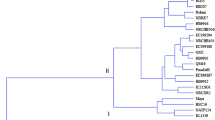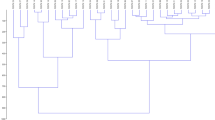Abstract
Protein, oil, carbohydrate and starch contents of seed, which were collected from places with latitude 9° N to 32° N, longitude 72° E to 85° E and rainfall 40 to 400 cm, varied significantly (P<0.05) among 12 provenances. Interestingly, seed protein was positively correlated (r=0.838,P<0.05), and on the contrary, carbohydrate and starch were negatively correlated (r=−0.755,r=−0.623, respectively,P<0.05), with the latitude of the seed source. Significant variation for N, P, K, Ca and Mg in stems and leaves of one-year and three-year-old plants was also observed when these provenances were grown at Hisar (29°10′ N, 75° 46′ E, 215 m alt.), an arid region in north India. In general, provenances from north India at the age of three years had greater chemical and mineral contents than those from south India. Chlorophyll content was highly correlated with the latitude of the seed source, at the ages of one and three years (r=0.742,r=0.659,P<0.05, respectively), while crude protein of foliage at the age of three years was significantly correlated (r=0.673) with latitude. Dehradun, Jammu and Hisar provenances, from the north had comparatively greater concentrations of N, P and K at the age of three years as compared to those from south India. The results are useful from the points of view of genetical variation, and selection of superior provenances for arid conditions in north India.
Similar content being viewed by others
References
Alberdi M, Meza-Basso L, Fernandez J, Rios D and Romero M (1989) Seasonal changes in carbohydrate content and frost resistance of leaves ofNothofagus species. Phytochem 28: 159–163
Allen SE, Grimshaw HM, Parkinson JA and Quarmby C (1974) Chemical Analysis of Ecological Materials, Blackwell Scientific Publications, Oxford
Bisht RP, Toky OP and Singh SP (1992) Growth characteristics of important multipurpose nitrogen fixing trees of arid climates of India. Nitrogen Fixing Tree Res Report 10: 45–46
Bisht RP and Toky OP (1993) Growth pattern and architectural analysis of nine important multipurpose trees in an arid region of India. Can J For Res 23: 722–730
Bopp LA (1971) Variation in the content of foliar N, P and K inPinus sylvestris of different provenances. Biol. Nauki 1: 61–63
Burley J, Huxley PA and Owino F (1984) Design, management and assessment of species, provenance and breeding trials of multipurpose trees. In: Barnes RD and Gibson GL, eds, Provenance and Genetic Improvement Strategies in Tropical Forest Trees, pp 70–80. Commonwealth Forestry Institute, Oxford, UK
Cannel MGR (1982) Crop and isolation ideotypes evidence for progeny differences in nursery grownPicea sitchensis. Silvae Genet 31: 60–66
Von Carlowitz PG (1986) Defining ideotypes of multipurpose trees for their phenotypic selection and subsequent breeding. Proc International Workshop on ‘Biological Diversity and Genetic Resources of Underexploited Plants’, Kew, UK, 14 pp
Cleg KM (1956) The application of anthrone regeant to the estimation of starch in cereals. J Sci Food Agric 7: 40–44
Driessche RVD (1973) Foliar nutrient concentration difference between provenances of doughlas fir and their significance to foliar analysis interpretation. Can J For Res 3: 323–328
Fobee H and Giertych M (1970) Phosphorus uptake by spruce (Picea abies (L.) Karst.) seedlings of various provenances. Arboretum Kornickie 15: 99–115
Ganguli BN, Kaul RN and Nambiar KTN (1964) Preliminary studies on a few top feed species. Ann Arid Zone 3: 31–37
Gupta SK, Dhawan K and Yadav TP (1985) Estimation of oil content by wide-line NMR. Oil Crops Newsletter 2: 17–21
Hiscox JD and Israelstam (1979) A method for extraction of chlorophyll from leaf tissue without maceration. Can J Bot 57: 1332–1334
Khosla PK, Toky OP, Bisht RP and Hamidullah S (1992) Leaf dynamics and protein content of six important fodder trees of the western Himalaya. Agroforestry Systems 19: 109–118
Lee WG and Fenner M (1989) Mineral nutrient allocation in seeds and shoots of twelveChionochloa species in relation to soil fertility. J Ecol 77: 704–716
Lukyanetes VB (1980) Content of N and elements in leaves of Oak of various provenances. Lesovedenie 1: 52–57
Lunderstadt J (1980) The ecophysiological significances of phenols and proteins in needles of spruce. Zeitschrift für Planzenernährung und Bodenkunde 143: 412–421
von Maydell HJ (1986) Trees and Shrubs of the Sahel: Their Characteristics and Uses, Eschborn, Germany, 532 pp
Nair PKR (ed) (1989) Agroforestry Systems in the Tropics. Kluwer Academic Publishers, Dordrecht, The Netherlands, 674 pp
Panse VG and Sukhatme PV (1978) Statistical Methods for Agricultural Workers. ICAR, New Delhi, 347 pp
Semikhov VF (1978) Biochemical evaluation of bamboos. Byulleten Glavonogo Botanicheskogo Sada No 108: 42–47
Sniezko RA and Stewart HTL (1989) Range-wide provenance variation in growth and nutrition ofAcacia albida seedlings propagated in Zimbabwe. For Ecol Manage 27: 179–197
Toky OP and Bisht RP (1992) Observations on the rooting patterns of some agroforestry trees in an arid region of north-western India. Agroforestry Systems 18: 245–263
Toky OP, Bisht RP and Singh SP (1992) Growth and biomass allocation in six multipurpose nitrogen fixing trees of arid regions in India. Nitrogen Fixing Tree Res Report 10: 59–61
Wood PJ and Burley J (1991) A Tree for All Reasons: The Introduction and Evaluation of Multipurposes Trees for Agroforestry ICRAF, Nairobi, Kenya, 158 pp
Author information
Authors and Affiliations
Rights and permissions
About this article
Cite this article
Kumar, N., Toky, O.P. Variation in chemical contents of seed, and foliage inAlbizia lebbek (L.) Benth. of different provenances. Agroforest Syst 25, 217–225 (1994). https://doi.org/10.1007/BF00707461
Issue Date:
DOI: https://doi.org/10.1007/BF00707461




